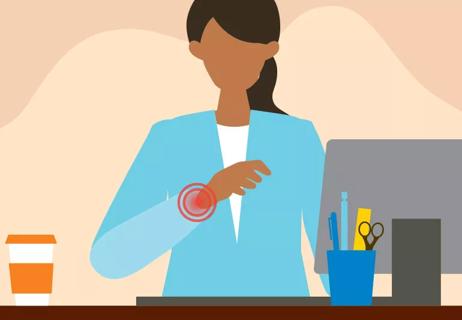Over-the-counter pain medications, typing pads and wrist braces can help when you’re in a wrist pinch

Your fingers are flying across the keyboard, shooting off emails, memos, proposals, summaries and updates. Those impressive typing skills serve you well.
Advertisement
Cleveland Clinic is a non-profit academic medical center. Advertising on our site helps support our mission. We do not endorse non-Cleveland Clinic products or services. Policy
But what happens when typing leads to aching wrists? We talked to orthopaedic surgeon Youssra Marjoua, MD, about what causes wrist or hand pain — and how to prevent it.
“Using a computer isn’t hazardous in and of itself,” Dr. Marjoua says. But if you have any underlying problems with your joints or soft tissues, all those repetitive keystrokes can increase the risk of a painful experience.
Common underlying problems include previous injuries, osteoarthritis of the small joints of your hand and wrist, as well as subtle changes in the curve of your spine or the alignment of your limbs as a result of aging.
“When you have any of those underlying issues, using your hands in a repetitive manner can exacerbate your symptoms,” says Dr. Marjoua.
And that’s not even specific to typing — these kinds of injuries can occur at higher frequencies when you work with your hands often, such as in the areas of construction, manufacturing, retail and musical performance.
The source of wrist pain isn’t always obvious. An interconnected framework of skeletal anatomy, soft tissues and nerve network exists from your neck to your fingertips, Dr. Marjoua says. Just like having a kink in one end of a garden hose can cause the water to stop at the other end, a kink in your neck or shoulder can cause problems downstream in your wrist or hand.
Advertisement
Several things can cause pain in your wrists and hands. Some of the more common suspects include:
This common condition causes pain, numbness, tingling or weakness in the hand or wrist. It presents when swollen tendons press on a nerve in the wrist or a ligament presses down on the nerve, making it difficult to feel or handle small objects like holding a book, writing or using a keyboard. If left untreated, it can result in constant numbness or hand weakness which can disrupt your ability to function and participate in daily tasks.
Also known as ulnar nerve entrapment, this condition is similar to carpal tunnel except it involves a single nerve that can become compressed at your elbow with presenting symptoms in your hand. It causes numbness and tingling mainly in your ring and small fingers, but it can also create hand weakness and affect your ability to grasp items with difficulty straightening your pinky and ring fingers.
There are more than 100 types of arthritis that can cause swelling, pain and stiffness in the joints. Two of the most common types that can make wrists and hands hurt include:
The key to preventing wrist pain is to make sure you’re providing your hands with the support they need as you go about your day doing some of your favorite activities and other work.
Check your setup: Ergonomically arrange your monitor, mouse and keyboard for your height and body size so you avoid overworking your muscles, tendons and joints.
Sit straight: Make sure you’re sitting comfortably at your desk and not hunching or leaning forward. Remember: Poor posture can present a slew of unwanted problems.
Arm yourself: Position your wrists and forearms so they’re neutral or nearly straight (not tilted up or down) as you type. This will help reduce repetitive strain injuries that can have a long-term effect on hand and wrist pain.
Move it: Get up to stretch and move regularly. One way to do this is to consider quick exercise snacks between meetings or to break up longer projects.
Go up and down: If possible, switch between sitting and standing as you work. The extra movement will not only help you loosen your joints, but it will help strengthen some of your tendons, too.
You can use over-the-counter pain medicine to help relieve wrist pain and swelling. The use of different typing pads and wrist braces can also provide a simple remedy. If you have occasional aches in your wrists after a long day of typing, it’s usually not concerning for underlying injury, says Dr. Marjoua — especially if it goes away when you stretch or if it resolves within a few days of using these simple remedies.
Advertisement
But if the symptoms persist (or keep coming back in the same spot), and it’s interrupting your ability to do everyday tasks, it’s time to see a doctor to find out what’s going on. Treatments vary, but often, the guidance of a certified hand therapist can also help.
“Pain is a defense mechanism. It’s telling you there’s something wrong with your body,” Dr. Marjoua states. “If your hand or wrist pain is not going away, seek medical evaluation.”
Advertisement
Learn more about our editorial process.
Advertisement

Wrist flexor and extensor stretches are the best stretches for wrist pain

After knee arthroplasty, swelling-related pain is common, but infection and blood clots are also risks

It can be harder to let go when you’ve invested time, energy and emotions — but it might be the healthier choice long term

Pointing out how their behavior makes you feel and giving them projects to own can help you both

Working beyond your limits can increase illnesses and accidents related to your physical and mental well-being

Help calm the angst that can come with the start of a new work week by adopting a positive mindset, planning an activity and getting some exercise

Hanging upside down for any length of time may decompress the tension in your spine

Stretches, exercises and posture changes can help address lower cross syndrome

The best parenting style balances enforcing rules and showing plenty of love

Tips include cutting back on sugar, focusing on exercise and managing stress

It can be harder to let go when you’ve invested time, energy and emotions — but it might be the healthier choice long term